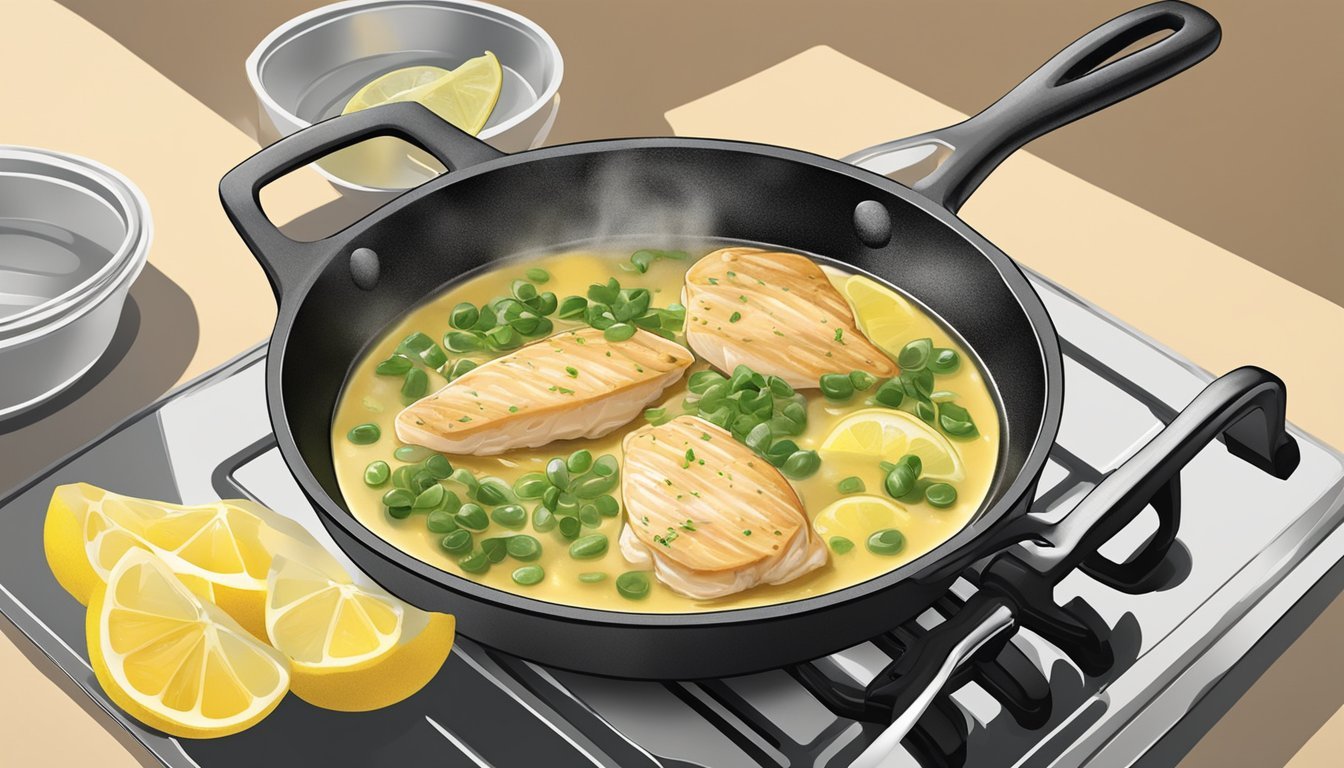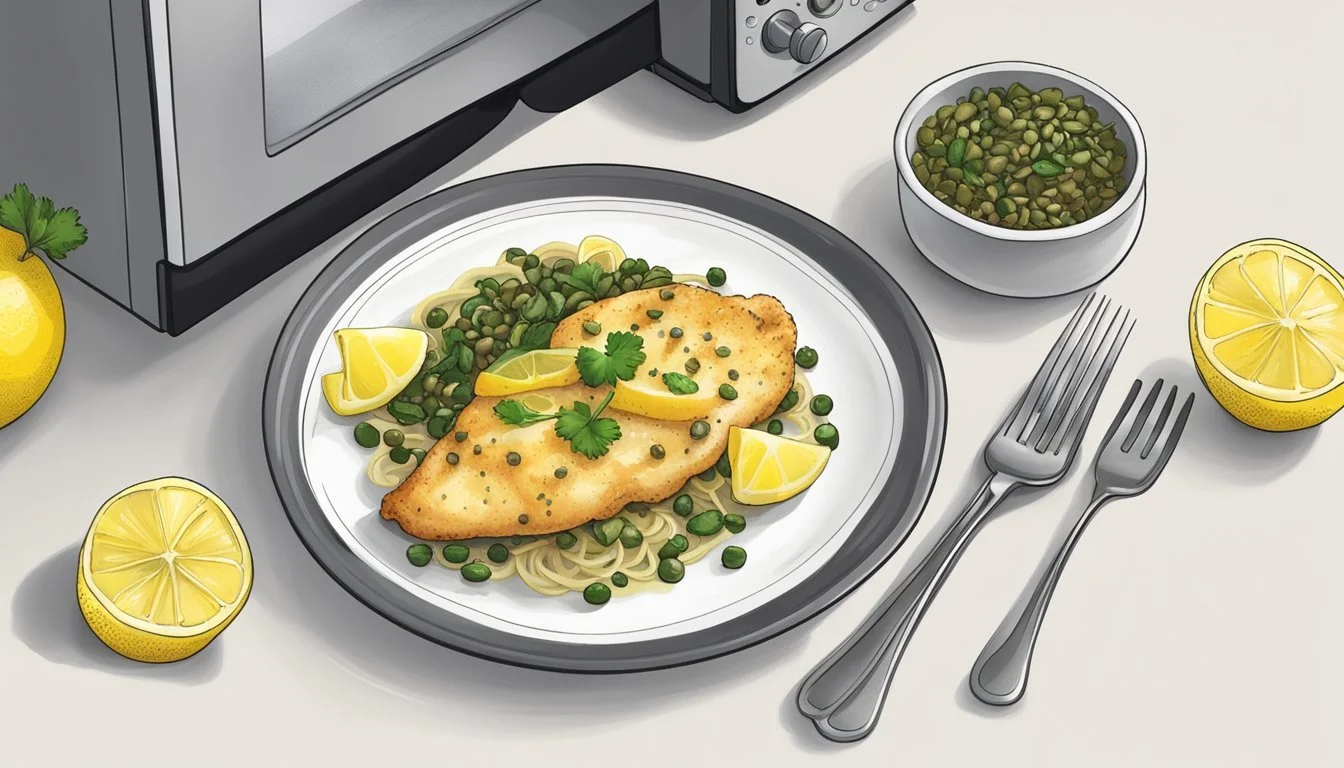How to Reheat Gluten-Free Chicken Piccata for Perfect Flavor and Texture
Reheating gluten-free chicken piccata while preserving its delicate flavors and textures can be a challenge, but it is certainly achievable. To reheat gluten-free chicken piccata, layer the chicken into a microwavable dish, add a bit of broth, cover with plastic wrap, and heat on medium power for up to two minutes. Allow the dish to rest for another two minutes so the heat can distribute evenly. This method ensures that the chicken piccata remains moist and flavorful.
Another effective method involves reheating the dish on the stovetop. Place the chicken in a skillet over medium heat, add a bit of broth or water, and cover. Heat it gently, turning occasionally, until thoroughly warmed. This technique helps maintain the dish's texture and prevents the chicken from drying out.
Whether using the microwave or stovetop, be careful not to overheat the chicken piccata to avoid a tough texture. The addition of broth not only aids in reheating but also enhances the flavors, making your gluten-free chicken piccata taste as fresh and delicious as when it was first cooked.
Understanding Gluten-Free Chicken Piccata
Gluten-Free Chicken Piccata is a delicious and healthy variation of the traditional Italian dish. This version uses alternative flours and ingredients to cater to those with gluten sensitivities without compromising on taste.
Key Ingredients for Gluten-Free Version
The primary ingredients for gluten-free Chicken Piccata include chicken breast, gluten-free flour, and almond flour. Gluten-free flour and almond flour provide a similar texture and coating as traditional flour.
Fresh lemon juice and capers are crucial for the tangy flavor profile. Olive oil is typically used for sautéing the chicken, giving it a rich and robust taste. Chicken broth adds depth to the sauce.
Nutritional Profile
This dish offers a balanced nutritional profile, focusing on lean protein from the chicken breasts. The almond flour adds essential nutrients like healthy fats, fiber, and protein. Using olive oil provides heart-healthy monounsaturated fats.
Capers and lemon juice don't add significant calories but enhance the dish's flavor. A serving typically contains around 300-400 calories, depending on portion sizes and specific ingredients used.
Importance of Proper Storage
Proper storage ensures the dish maintains its flavor and safety. Store leftovers in an airtight container in the refrigerator for up to three days. For longer storage, the dish can be kept in the freezer for up to three months.
Make sure the chicken is completely cooled before sealing in the container to prevent condensation and sogginess. Reheat gently to preserve the texture and flavor.
Preparation Basics before Reheating
Before reheating gluten-free chicken piccata, ensure the chicken is cooked and sliced properly and stored under optimal conditions for preserving quality and flavor.
Initial Cooking and Slicing
Begin with boneless skinless chicken breasts. Use a sharp knife to trim any excess fat. Pound the chicken to an even thickness using a meat mallet. This ensures uniform cooking.
Cook the chicken until internal temperature reaches 165°F. Allow it to rest for a few minutes post-cooking. Slice the cooked chicken into portions suitable for reheating. Slicing the meat before refrigeration helps in achieving even reheating later.
Storage Tips
Store the chicken piccata properly to maintain its tenderness and flavor. Place the sliced chicken in an airtight container and pour any remaining sauce over it. This helps keep the meat moist and flavorful.
Refrigerate immediately if you plan to reheat within a few days. For longer storage, freeze the portions in vacuum-sealed bags. Label containers with dates to monitor freshness. Proper storage is key to ensuring the dish remains safe and flavorful when reheated.
Reheating Techniques
Reheating gluten-free chicken piccata can be done using various methods to ensure a delicious result. Each method offers a way to preserve the texture and flavor while ensuring the chicken is cooked through.
Oven Method
Preheat the oven to 350°F (175°C). Place the chicken piccata in an oven-safe dish and add a bit of broth or sauce to keep it moist. Cover the dish with aluminum foil to prevent the chicken from drying out.
Heat the chicken for 20-25 minutes and check the internal temperature, which should reach 165°F (75°C). Removing the foil for the last 5 minutes of heating can help crisp the coating.
Stovetop Method
Heat a nonstick skillet over medium heat for 2-3 minutes. Add a small amount of olive oil or butter to the skillet. Place the leftover chicken piccata in the skillet in a single layer.
Add a splash of broth, water, or lemon juice around the edges to maintain moisture. Cook each side for 2-3 minutes until heated through, ensuring an internal temperature of 165°F (75°C). This method helps retain the crispy texture of the coated chicken.
Microwave Tips
Place the chicken piccata in a microwave-safe dish and add a bit of broth to avoid drying. Cover the dish with plastic wrap, leaving a small vent. Use medium power for up to 2 minutes to avoid overcooking.
Allow the dish to sit for 2 minutes after heating, ensuring even heat distribution. Check that the internal temperature reaches 165°F (75°C).
Air Fryer Approach
Preheat the air fryer to 350°F (175°C). Place the chicken piccata in the air fryer basket in a single layer. Cook for 3-4 minutes until heated through.
Check the internal temperature, which should be at least 165°F (75°C). The air fryer is excellent for preserving the crispiness of the coating while reheating quickly.
Serving Suggestions
When serving reheated gluten-free chicken piccata, consider pairing it with complementary side dishes to create a balanced and satisfying meal. These accompaniments should enhance the flavors of the dish while also maintaining a gluten-free diet.
Accompaniment Ideas
Pasta: Gluten-free pasta varieties such as rice or corn-based pasta can be excellent options. Simple preparations with olive oil and fresh herbs like parsley or basil work well. Adding a touch of lemon zest can tie the flavors together with the chicken piccata.
Mashed Potatoes: Smooth, creamy mashed potatoes provide a comforting contrast to the tangy chicken piccata. Ensure they are made with gluten-free ingredients, such as using gluten-free stock or dairy-free alternatives.
Rice and Quinoa: Fluffy white rice or protein-rich quinoa pairs well with chicken piccata. Consider adding a squeeze of lemon and chopped herbs for extra zest and freshness.
Vegetables: Steamed or sautéed vegetables such as zucchini, broccoli, spinach, or asparagus can add a nutritious and colorful element to the plate. A light drizzle of olive oil and a pinch of salt can enhance their natural flavors.
Using these accompaniments, a reheated gluten-free chicken piccata can be part of an enjoyable and well-rounded dinner.
Maintaining Quality and Flavor
To maintain the quality and flavor of gluten-free chicken piccata when reheating, it is essential to prevent the chicken from drying out and to enhance the taste of the dish. Key ingredients like lemon, capers, fresh parsley, and butter play crucial roles in achieving this.
Preventing Dryness
Keeping the chicken moist is crucial for retaining its texture and taste. Reheat the chicken gently, either in an oven at 300°F (150°C) covered with aluminum foil or in a skillet over low heat.
Using broth or a bit of water can help maintain moisture. Add a few tablespoons of chicken stock to the pan before reheating, which keeps the chicken from becoming dry and adds back some richness.
Place cold butter on the chicken pieces before reheating, and this allows it to melt gradually, sealing in moisture and enhancing flavor. Avoid microwave reheating, as it can dry out the meat quickly.
Enhancing Taste after Reheating
To rejuvenate the flavors after reheating, consider refreshing the lemon butter sauce. Melt a bit of fresh butter in a skillet, add lemon juice, and zest to brighten the flavor. Pour this over the reheated chicken.
Adding freshly chopped parsley or extra capers can also revive the dish. These ingredients bring fresh, vibrant flavors that can sometimes diminish during storage.
If available, a small amount of olive oil and a squeeze of fresh lemon just before serving can provide an extra zing.
Cooking Variations and Adjustments
When reheating gluten-free chicken piccata, you can adapt the recipe to fit various dietary preferences and nutritional goals. Here are some approaches to adjust the dish while maintaining its delicious flavor.
Alteration for Dietary Preferences
Dairy-Free: If you need a dairy-free version, replace butter with a plant-based alternative. Coconut oil or a dairy-free margarine can work well without compromising the richness of the sauce. Ensure any stock used is also dairy-free.
Low-Carb/Keto: Substitute traditional gluten-free flours such as rice flour or tapioca starch with almond flour or coconut flour. This will help keep the dish low in carbohydrates while providing a suitable texture for dredging the chicken.
Other Gluten-Free Variations: Different gluten-free flours can offer diverse textures and flavors. Rice flour is a common substitute, yielding a lighter coating. Alternatively, a mix of almond flour and tapioca starch can provide a balanced, crisp crust. Each type of flour might slightly change the reheating process, so be mindful of texture consistency.
Conclusion
Reheating gluten-free chicken piccata is a quick and easy process. This makes it an ideal option for those busy weeknight meals. By following the proper techniques, you can ensure that the dish remains as flavorful and delicious as when it was first cooked.
Using methods like sous vide or the air fryer can help maintain the moisture and taste of the chicken. These techniques allow you to enjoy a healthy and convenient meal without compromising quality.
Microwaving or using a skillet are also effective ways to reheat leftovers. Just add a splash of broth or water to retain the dish's moisture. This maintains the tenderness of the chicken and enhances the overall taste experience.
For gluten-free chicken recipes, focusing on proper reheating methods is crucial. This preserves the dish’s unique flavors and keeps it enjoyable for future meals. Whether it's a quick dinner solution or part of a meal prep plan, reheating chicken piccata can be both simple and satisfying.






